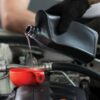DUBL-CHEK DR-64
Cleaner / Remover
- Every aerosol contains a direct spray tube for easy removal of white contrast paint.
- Can be used as a pre-cleaner for penetrant inspection evaporates completely and rapidly.
- Aerosols offer convenience and portability
- Can be used in the penetrant and magnetic particle inspection process.
DR-64 Cleaner / Remover can be used in the solvent remove penetrant process and to remove CP-2 white contrast paint from part surfaces. In the penetrant process it is a manual wipe on and wipe off material and is recommended for small areas. When removing CP-2 spray directly onto the surface and wipe. DR-64 may also be used for generally cleaning oily, dirty surfaces. DR-64 is especially suitable for cleaning prior to the application of inspection penetrants. Complies with low sulfur and low halogen requirements.
No information
Penetrant Process
1. Application: Apply penetrant only to clean, dry surfaces by spraying, flowing, brushing or dipping.
2. Dwell Time: After application, allow the penetrant to drain from the part surface back into the penetrant tank to conserve material.
3. Removal: Remove as much excess penetrant as possible using clean, dry rag or towelling. Remove remaining penetrant film by wiping with a lint free rag or towelling that has been slightly moistened with DR-64. Use a minimal of DR-64; avoid flushing penetrant from flaws. Do not spray DR-64 directly on the part surface when removing excess penetrant. Rough surfaces require more generous applications of DR-64.
4. Drying: Allow the surface to dry completely before applying developer.
5. Developing: Apply the developer by cloud, dusting, spray or dip using the appropriate developer. Flaw marks are visible under appropriate lighting almost immediately, but allow sufficient developing time to enhance the flaw visibility
6. Inspection: Inspect parts under appropriate light.
Magnetic Particle Process
1. Clean the test surface and allow it to dry.
2. The longer CP-2 is stirred or agitated the more uniform the spray.
3. Apply a thin coat of CP-2 to the inspection area from a distance of approximately 150mm from the surface.
4. Wait approximately 20 seconds, depending of ambient temperature, for the paint to dry.
5. Magnetise the area to be inspected.
6. Ensure continuous agitation of the suspension fluid. If using an aerosol, shake vigorously before and during inspection.
7. Apply the suspension to the test part.
8. Allow the excess oil/water to run off the inspection area.
9. Inspect the surface under visible light.
10. Collections of particles will reveal discontinuities at the leakage fields.
11. Clean and repeat the process, changing the orientation of the magnetising direction.
12. DR-64 can be used to remove CP-2 after the process is completed.
• QPL-AMS-2644 listing
• MIL-I-25135 Revisions C, D & E
• ASME Code NDT, Sec V
• SAE AMS 2644
Colour: Colourless
Liquid Volatility: 100%
Odour: low petroleum smell
Temperature limit: 4°C to 50°C
| Code | Packaging |
|---|---|
| 1505/400 | 400ml Aerosol |
| 1505/42 | 3.8 litres (1 gallon) |
| 1505/51 | 18.9 litres (5 gallons) |
| 1505/64 | 208 litres (55 gallons) |













